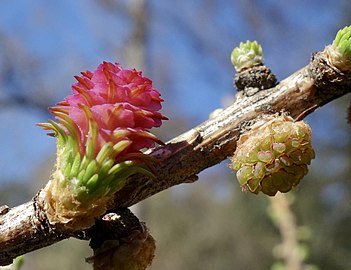Larix sibirica
| Larix sibirica | |
|---|---|

| |
| Siberian larch in Montreal Botanic Gardens | |
| Scientific classification | |
| Kingdom: | Plantae |
| Clade: | Tracheophytes |
| Clade: | Gymnospermae |
| Division: | Pinophyta |
| Class: | Pinopsida |
| Order: | Pinales |
| Family: | Pinaceae |
| Genus: | Larix |
| Species: | L. sibirica
|
| Binomial name | |
| Larix sibirica | |
| Synonyms | |
|
List[2]
| |
Larix sibirica, the Siberian larch or Russian larch, is a frost-hardy tree native to western
Description
It is a medium-size to large
The male and female cones are borne separately on the same tree; pollination is in early spring. The male cones are solitary, yellow, globose to oblong, 4–8 mm diameter, and produce wingless pollen. The mature female cones are erect, ovoid-conic, 2–5 cm long, with 30-70 erect or slightly incurved (not reflexed) and downy seed scales; they are green variably flushed red when immature, turning brown and opening to release the winged seeds when mature, 4–6 months after pollination. The old cones commonly remain on the tree for many years, turning dull grey-black. The minimum seed-bearing age is 10–15 years.
Uses
Because of its rot resistance, larch wood is especially valuable for posts, poles,
It is also used in many velodromes around the world as the track surface including the Manchester Velodrome[3] and the Velodrome Krylatskoye in Moscow.[4]
It is grown in Canada and the northern United States to a limited extent, first cultivated there in 1806. It was also introduced to Iceland and Greenland.
It is faster-growing than many other coniferous trees in cold regions, but requires full sunlight. When grown in plantations it should be kept widely spaced, and intensive thinning is required.
Resin of siberian larch (as well as of
- See also List of Lepidoptera that feed on larches
Larix sibirica cone scales are used as food by the
Gallery
-
Young female cone
-
Female cone (left), male cone (right)
-
Short shoots after bud break
-
Crowns of Siberian larch in winter
References
- . Retrieved 12 December 2017.
- ^ "Larix sibirica Ledeb". Plants of the World Online. Board of Trustees of the Royal Botanic Gardens, Kew. 2017. Retrieved 11 April 2021.
- britishcycling.org.uk. 2007-11-01. Retrieved 2008-02-28. [dead link]
- ^ "UCI World Cup Classics" (PDF). UCI. Retrieved 2008-02-28. [dead link]
- ^ Wild Siberian Larch Resin Natural Chewing Gum
External links
 Media related to Larix sibirica at Wikimedia Commons
Media related to Larix sibirica at Wikimedia Commons- Larix sibirica images at the Arnold Arboretum of Harvard University Plant Image Database
- Gymnosperm Database
- Siberian larch cones photographs





